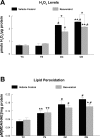Mediation of endogenous antioxidant enzymes and apoptotic signaling by resveratrol following muscle disuse in the gastrocnemius muscles of young and old rats
- PMID: 20861279
- PMCID: PMC3007185
- DOI: 10.1152/ajpregu.00489.2010
Mediation of endogenous antioxidant enzymes and apoptotic signaling by resveratrol following muscle disuse in the gastrocnemius muscles of young and old rats
Abstract
Hindlimb suspension (HLS) elicits muscle atrophy, oxidative stress, and apoptosis in skeletal muscle. Increases in oxidative stress can have detrimental effects on muscle mass and function, and it can potentially lead to myonuclear apoptosis. Resveratrol is a naturally occurring polyphenol possessing both antioxidant and antiaging properties. To analyze the capacity of resveratrol to attenuate oxidative stress, apoptosis and muscle force loss were measured following 14 days of HLS. Young (6 mo) and old (34 mo) rats were administered either 12.5 mg·kg(-1)·day(-1) of trans-resveratrol, or 0.1% carboxymethylcellulose for 21 days, including 14 days of HLS. HLS induced a significant decrease in plantarflexor isometric force, but resveratrol blunted this loss in old animals. Resveratrol increased gastrocnemius catalase activity, MnSOD activity, and MnSOD protein content following HLS. Resveratrol reduced hydrogen peroxide and lipid peroxidation levels in muscles from old animals after HLS. Caspase 9 abundance was reduced and Bcl-2 was increased, but other apoptotic markers were not affected by resveratrol in the gastrocnemius muscle after HLS. The data indicate that resveratrol has a protective effect against oxidative stress and muscle force loss in old HLS animals; however, resveratrol was unable to attenuate apoptosis following HLS. These results suggest that resveratrol has the potential to be an effective therapeutic agent to treat muscle functional decrements via improving the redox status associated with disuse.
Figures





Similar articles
-
Effects of resveratrol on the recovery of muscle mass following disuse in the plantaris muscle of aged rats.PLoS One. 2013 Dec 12;8(12):e83518. doi: 10.1371/journal.pone.0083518. eCollection 2013. PLoS One. 2013. PMID: 24349525 Free PMC article.
-
Green tea extract attenuates muscle loss and improves muscle function during disuse, but fails to improve muscle recovery following unloading in aged rats.J Appl Physiol (1985). 2015 Feb 1;118(3):319-30. doi: 10.1152/japplphysiol.00674.2014. Epub 2014 Nov 20. J Appl Physiol (1985). 2015. PMID: 25414242 Free PMC article.
-
Epigallocatechin-3-gallate improves plantaris muscle recovery after disuse in aged rats.Exp Gerontol. 2014 Feb;50:82-94. doi: 10.1016/j.exger.2013.11.011. Epub 2013 Dec 3. Exp Gerontol. 2014. PMID: 24316035 Free PMC article.
-
Anti-inflammatory effects of resveratrol: possible role in prevention of age-related cardiovascular disease.Ann N Y Acad Sci. 2011 Jan;1215:117-22. doi: 10.1111/j.1749-6632.2010.05848.x. Ann N Y Acad Sci. 2011. PMID: 21261649 Free PMC article. Review.
-
Experimental studies of the molecular pathways regulated by exercise and resveratrol in heart, skeletal muscle and the vasculature.Molecules. 2014 Sep 18;19(9):14919-47. doi: 10.3390/molecules190914919. Molecules. 2014. PMID: 25237749 Free PMC article. Review.
Cited by
-
Muscle Atrophy Induced by Mechanical Unloading: Mechanisms and Potential Countermeasures.Front Physiol. 2018 Mar 20;9:235. doi: 10.3389/fphys.2018.00235. eCollection 2018. Front Physiol. 2018. PMID: 29615929 Free PMC article. Review.
-
Long-term supplementation with a cystine-based antioxidant delays loss of muscle mass in aging.J Gerontol A Biol Sci Med Sci. 2013 Jul;68(7):749-59. doi: 10.1093/gerona/gls334. Epub 2013 Mar 4. J Gerontol A Biol Sci Med Sci. 2013. PMID: 23459206 Free PMC article.
-
Monotropein Improves Dexamethasone-Induced Muscle Atrophy via the AKT/mTOR/FOXO3a Signaling Pathways.Nutrients. 2022 Apr 29;14(9):1859. doi: 10.3390/nu14091859. Nutrients. 2022. PMID: 35565825 Free PMC article.
-
Human Umbilical Cord Wharton's Jelly Derived Mesenchymal Stromal Cells May Attenuate Sarcopenia in Aged Mice Induced by Hindlimb Suspension.Med Sci Monit. 2018 Dec 20;24:9272-9281. doi: 10.12659/MSM.913362. Med Sci Monit. 2018. PMID: 30571669 Free PMC article.
-
Acetylation and deacetylation--novel factors in muscle wasting.Metabolism. 2013 Jan;62(1):1-11. doi: 10.1016/j.metabol.2012.03.019. Epub 2012 May 22. Metabolism. 2013. PMID: 22626763 Free PMC article. Review.
References
-
- Adhihetty PJ, O'Leary MF, Chabi B, Wicks KL, Hood DA. Effect of denervation on mitochondrially mediated apoptosis in skeletal muscle. J Appl Physiol 102: 1143–1151, 2007 - PubMed
-
- Adhihetty PJ, O'Leary MF, Hood DA. Mitochondria in skeletal muscle: adaptable rheostats of apoptotic susceptibility. Exerc Sport Sci Rev 36: 116–121, 2008 - PubMed
-
- Adhihetty PJ, O'Leary MF, Hood DA. Mitochondria in skeletal muscle: adaptable rheostats of apoptotic susceptibility. Exerc Sport Sci Rev 36: 116–121, 2008 - PubMed
Publication types
MeSH terms
Substances
Grants and funding
LinkOut - more resources
Full Text Sources
Other Literature Sources
Medical

